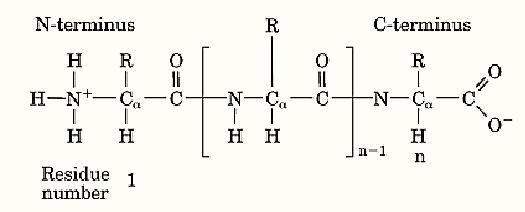


 النبات
النبات
 الحيوان
الحيوان
 الأحياء المجهرية
الأحياء المجهرية
 علم الأمراض
علم الأمراض
 التقانة الإحيائية
التقانة الإحيائية
 التقنية الحيوية المكروبية
التقنية الحيوية المكروبية
 التقنية الحياتية النانوية
التقنية الحياتية النانوية
 علم الأجنة
علم الأجنة
 الأحياء الجزيئي
الأحياء الجزيئي
 علم وظائف الأعضاء
علم وظائف الأعضاء
 الغدد
الغدد
 المضادات الحيوية
المضادات الحيوية|
Read More
Date: 13-12-2015
Date: 22-12-2015
Date: 7-3-2021
|
C-Terminus
The C-terminus is the term for one end of the polypeptide chain of a protein. Proteins are polymers formed by condensation of the amino groups and carboxyl groups of amino acids. That end of the polypeptide chain having an uncondensed or “free” carboxyl group is called the carboxyl terminus, or C-terminus (Fig. 1). By convention, the C-terminus is the last residue in the protein sequence or primary structure. Similarly, the other end of the polypeptide chain, having an uncondensed or free amino group, is termed the amino terminus, or N-terminus, and by convention it is the first residue in the protein sequence. The C-terminal carboxyl group is usually negatively charged at physiological pH.

Figure 1. Schematic representation of a protein, showing the C-terminus as the last residue in the polypeptide chain. The square brackets indicate the repeating part of the chain (the backbone), and the R group denotes the variable side chain of each amino acid residue. The N-terminus is the first residue in the chain.
The C-terminal carboxyl group can be changed by post-translational modification such as amidation. An amidated C-terminus is more common in smaller proteins, or peptides, including hormones and toxins, and may be important for biological function or stability. Another important covalent modification that occurs only at the C-terminal residue is the attachment of membrane anchors to secure an otherwise water-soluble protein to a hydrophobic membrane. Proteins can be degraded by carboxypeptidases that specifically hydrolyze the C-terminal peptide bond.



|
|
|
|
دراسة تحدد أفضل 4 وجبات صحية.. وأخطرها
|
|
|
|
|
|
|
العتبة العباسية تستعدّ لتكريم عددٍ من الطالبات المرتديات للعباءة الزينبية في جامعات كركوك
|
|
|